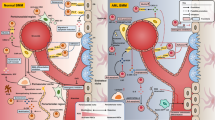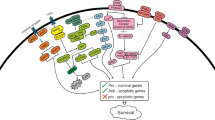Abstract
Chronic myeloid leukemia (CML) is a three-stage myeloproliferative disease caused by translocation between chromosomes 9 and 22. Although tyrosine kinase inhibitors (TKI) are highly effective in the treatment of CML, numerous clinical trials have shown that many patients become refractory or drug resistance, especially those in the blastic crisis of CML. The molecular mechanisms underlying CML, however, remain poorly understood. In the present study, we used a coculture model to address possible mechanisms underlying the involvement of bone marrow microenvironment in the drug resistance of CML. Our data show that interleukin-7(IL-7) levels in the bone marrow of CML patients in blastic crisis are significantly higher than those of both healthy persons and CML patients in chronic and accelerated phases. The increased IL-7 was secreted by mesenchymal stem cells (MSC) in the bone marrow, which may protect leukemic cells from apoptosis induced by imatinib through JAK1/STAT5 signaling pathway. Our findings suggest that therapeutic strategies IL-7 signaling pathway may represent a promising approach for improving CML therapy, especially for patients in blastic crisis.





Similar content being viewed by others
References
Sawyers CL. Chronic myeloid leukemia. New Engl J Med. 1999;340:1330–40.
Deininger M, Goldman JM, Lydon N, Melo JV. The tyrosine kinase inhibitor CGP57148B selectively inhibits the growth of BCR-ABL-positive cells. Blood. 1997;90:3691.
Druker BJ, Tamura S, Buchdunger E, Ohno S, Segal GM, Fanning S, et al. Effects of a selective inhibitor of the Abl tyrosine kinase on the growth of Bcr-Abl positive cells. Nat Med. 1996;2:561–6.
Druker BJ, Guilhot F, O’Brien SG, Gathmann I, Kantarjian H, Gattermann N, et al. Five-year follow-up of patients receiving imatinib for chronic myeloid leukemia. New Engl J Med. 2006;355:2408–17.
Sawyers CL, Hochhaus A, Feldman E, Goldman JM, Miller CB, Ottmann OG, et al. Imatinib induces hematologic and cytogenetic responses in patients with chronic myelogenous leukemia in myeloid blast crisis: results of a phase II study. Blood. 2002;99:3530–9.
O’Brien SG, Guilhot F, Larson RA, Gathmann I, Baccarani M, Cervantes F, et al. Imatinib compared with interferon and low-dose cytarabine for newly diagnosed chronic-phase chronic myeloid leukemia. New Engl J Med. 2003;348:994–1004.
Parker WT, Ho M, Scott HS, Hughes TP, Branford S. Brief report Poor response to second-line kinase inhibitors in chronic myeloid leukemia patients with multiple low-level mutations, irrespective of their resistance profile. Blood. 2012;119:2234–8.
Ma L, Shan Y, Bai R, Xue L, Eide CA, Ou J, et al. A therapeutically targetable mechanism of BCR-ABL-independent imatinib resistance in chronic myeloid leukemia. Sci Transl Med. 2014;6(252):4531–6.
Quintes-Cardama A, Kantarjian HM, Cortes JE. Mechanisms of primary and secondary resistance to imatinib in chronic myeloid leukemia. Cancer Control. 2009;16:122–31.
Hochhaus A, Kreil S, Corbin AS, La Rosee P, Muller MC, Lahaye T, et al. Molecular and chromosomal mechanisms of resistance to imatinib (ST1571) therapy. Leukemia. 2002;16:2190–6.
Ursan LD, Jiang R, Pickard EM, Lee TA, Ng D, Pickard AS. Emergence of BCR-ABL kinase domain mutations associated with newly diagnosed chronic myeloid leukemia: a meta-analysis of clinical trials of tyrosine kinase inhibitors. J Manag Care Pharm. 2015;21:114–22.
Peterson LF, Mitrikeska E, Giannola D, et al. p53 stabilization induces apoptosis in chronic myeloid leukemia blast crisis cells. Leukemia. 2011;25:761–9.
Nair RR, Tolentino J, Hazlehurst LA. The bone marrow microenvironment as a sanctuary for minimal residual disease in CML. Biochem Pharmacol. 2010;80:602–12.
Zhang B, Ho YW, Huang Q, et al. Altered microenvironmental regulation of leukemic and normal stem cells in chronic myelogenous leukemia. Cancer Cell. 2012;21:577–92.
Shahrabi S, Azizidoost S, Shahjahani M, Rahim F, Ahmadzadeh A, Saki N. New insights in cellular and molecular aspects of BM niche in chronic myelogenous leukemia. Tumor Bio. 2014;35:10627–33.
Houthuijzen JM, Daenen LG, Roodhart JM, Voest EE. The role of mesenchymal stem cells in anti-cancer drug resistance and tumour progression. Br J Cancer. 2012;106:1901–6.
Estrada-González PK, Gómez-Ceja L, Montesinos JJ, Mayani H, Chávez-González A, Meillón L, et al. Decreased frequency, but normal functional integrity of mesenchymal stromal cells derived from untreated and imatinib-treated chronic myeloid leukemia patients. Leuk Res. 2014;38:594–600.
Tabe Y, Konopleva M. Advances in understanding the leukaemia microenvironment. Brit J Haematol. 2014;164:767–78.
Etet PFS, Vecchio L, Kamdje AHN. Signaling pathways in chronic myeloid leukemia and leukemic stem cell maintenance: key role of stromal microenvironment. Cell Signal. 2012;24:1883–8.
Li X, Miao H, Zhang Y, Li W, Li Z, Zhou Y, et al. Bone marrow microenvironment confers imatinib resistance to chronic myelogenous leukemia and oroxylin A reverses the resistance by suppressing Stat3 pathway. Arch Toxicol. 2015;89:121–36.
Grabstein KH, Waldschmidt TJ, Finkelman FD, et al. Inhibition of murine B-lymphopoiesis and T lymphopoiesis in vivo by an anti-interleukin-7 monoclonal-antibody. J Exp Med. 1993;178:257–64.
Carrette F, Surh CD. IL-7 signaling and CD127 receptor regulation in the control of T cell homeostasis. Semin Immunol. 2012;24:209–17.
Goodwin RG, Lupton S, Schmierer A, et al. Human interleukin 7: molecular cloning and growth factor activity on human and murine B-lineage cells. P Natl Acad Sci USA. 1989;86:302–6.
Lundström W, Fewkes NM, Mackall CL. IL-7 in human health and disease. Semin Immunol. 2012;24:218–24.
Vianello F, Villanova F, Tisato V, Lymperi S, Ho KK, Gomes AR, et al. Bone marrow mesenchymal stromal cells non-selectively protect chronic myeloid leukemia cells from imatinib-induced apoptosis via the CXCR4/CXCL12 axis. Haematologica. 2010;95:1081–9.
Zhang B, Li M, McDonald T, et al. Microenvironmental protection of CML stem and progenitor cells from tyrosine kinase inhibitors through N-cadherin and Wnt-β-catenin signaling. Blood. 2013;121:1824–38.
Schafranek L, Nievergall E, Powell JA, Hiwase DK, Leclercq T, Hughes TP, et al. Sustained inhibition of STAT5, but not JAK2, is essential for TKI-induced cell death in chronic myeloid leukemia. Leukemia. 2015;29:76–85.
Beider K, Darash-Yahana M, Blaier O, Koren-Michowitz M, Abraham M, Wald H, et al. Combination of imatinib with CXCR4 antagonist BKT140 overcomes the protective effect of stroma and targets CML in vitro and in vivo. Mol Can Ther. 2014;13:1155–69.
Quintarelli C, De Angelis B, Errichiello S, Caruso S, Esposito N, Colavita I, et al. Selective strong synergism of Ruxolitinib and second generation tyrosine kinase inhibitors to overcome bone marrow stroma related drug resistance in chronic myelogenous leukemia. Leukemia Res. 2014;38:236–42.
Wang Y, Cai D, Brendel C, Barett C, Erben P, Manley PW, et al. Adaptive secretion of granulocyte-macrophage colony-stimulating factor (GM-CSF) mediates imatinib and nilotinib resistance in BCR/ABL+progenitors via JAK-2/STAT-5 pathway activation. Blood. 2007;109:2147–55.
Warsch W, Kollmann K, Eckelhart E, Fajmann S, Cerny-Reiterer S, Holbl A, et al. High STAT5 levels mediate imatinib resistance and indicate disease progression in chronic myeloid leukemia. Blood. 2011;117:3409–20.
Acknowledgments
We would like to thank the staff of the Jiangxi Key Laboratory of Molecular Medicine for their technical support and those of Department of Hematology, the Second Affiliated Hospital of Nanchang University for the collection of specimens. This study is supported by Grants from National Natural Science Foundation of China (81260231), Major Basic Research Projects of Jiangxi Province (20143ABC20005), Jiangxi Provincial Health and Family Planning Commission Science and Technology Program (20155645), Graduate Student Innovation Fund of Jiangxi Province (YC2014-B023).
Author information
Authors and Affiliations
Corresponding author
Ethics declarations
Conflict of interest
The authors declare that there are no conflicts of interest.
Additional information
X. Zhang and H. Tu contribute equally to this study and share first authorship.
About this article
Cite this article
Zhang, X., Tu, H., Yang, Y. et al. High IL-7 levels in the bone marrow microenvironment mediate imatinib resistance and predict disease progression in chronic myeloid leukemia. Int J Hematol 104, 358–367 (2016). https://doi.org/10.1007/s12185-016-2028-9
Received:
Revised:
Accepted:
Published:
Issue Date:
DOI: https://doi.org/10.1007/s12185-016-2028-9




